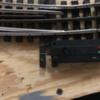Darn! I see that the point isn't tight against the stock rail. Can you apply an extra volt or two to the switch to see if it snaps into place?
I saw that gap as well, and I can't push it over any further either. The switch is not wired up at this point, as it has no where to go from the turnout. I just set up the loop temporarily to ferret out these kinds of details before actually doing the final positioning and wiring.
Now, I did take a needle nose pliers, and very gently bent the point toward the mating track, then gave it just a bit of a rotational twist, to bring the top edge into position as well.
The Berkshire now passes thru with no issues. The front truck rolls thru like it should. I plan to tweak it a bit more, and then smooth out the hump a bit, with my Dremel, as well.
I have attached a pic that switch, before the modification, along with a pic of the second switch, and there is marked difference, where the second one is a nice tight fit, and the Berkshire has not issues passing thru it.
--------------------------------------------
I have also discovered that this track has to be very accurately positioned.
That issue of the curve, where I had to shim up the inside of the turn, led me to believe that I did not have it in a true 90 degree angle, and that it might have been ever so slightly, for lack of a better way of putting it, kinked. I rearranged the leg going into it a but, and is now not a problem.
I think that I this was the issue with the Pency Flyer, as there are other 90 degree curves where, if one end of the loco is on one piece of track, and the other end is on the adjoining piece of track, it wobbles. One wheel on one end will be on the track, while the opposite wheel on the other end will be on the track, with one of the other two wheels in the air, and able to walk out of the track.
I would like some ideas on how to get the setup accurate enough to remove these issues.
I will also contact Steve about these issues, and I am sure that he will have helpful suggestions.
![]()







